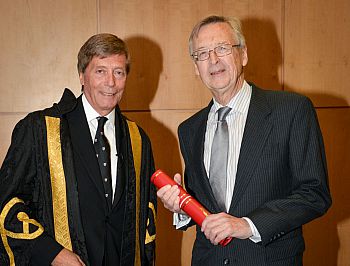Obituary: Professor Mike Pendlebury
Professor John Michael (Mike) Pendlebury, who has died at the age of 78, was an experimental physicist of the “old school” with a great love of building experimental equipment, making precision measurements and understanding their theoretical relevance.
 Professor John Michael (Mike) Pendlebury (right) pictured with the University's Vice-Chancellor Michael Farthing, receiving a Sussex 50th-anniversary fellowship.
Professor John Michael (Mike) Pendlebury (right) pictured with the University's Vice-Chancellor Michael Farthing, receiving a Sussex 50th-anniversary fellowship.
Mike obtained a first class degree in physics and worked on atomic beams under Ken Smith for his PhD before moving in 1962 to the University of Sussex, where Smith was the founding Professor of Experimental Physics.
For the subsequent 50 years Mike played a significant role in both the teaching and research of the University.
He was an early enthusiast for the use of new technology and, in particular, the use of computers for research and teaching.
The research activities of this newly formed group in Sussex soon transferred their expertise from atomic beams to neutrons. Neutrons are a basic constituent of the nucleus; they have no electric charge but do possess a magnetic moment.
Norman Ramsey of Harvard University had suggested in 1950 that neutrons may in addition have an electric dipole moment (EDM), corresponding to an anisotropic distribution of electric charge. This area of research using free neutrons formed the driving force for Mike’s work throughout his professional career. It is tremendously important in constraining theories of physics beyond our current Standard Model, and in trying to understand the reason that the Universe contains matter but no antimatter.
Mike was also the ‘Father of Ultra Cold Neutron (UCN)’ physics in the UK. Just as light can be trapped in a fibre, so neutrons can under the right conditions be trapped in a ‘bottle’. For this the neutrons are required to have extremely low velocities.
Mike set out to construct a proto-type ‘UCN source’ in the basement at Sussex - a set-up which today would give managers nightmares. Initially the number of low-velocity neutrons produced was very small, but the principle was established which has lived on through other UCN sources today.
Mike then also developed the theoretical ideas for a cryogenically based UCN source. This had to wait for another 20 years before the ideas were experimentally confirmed, although today this type of UCN source is the standard at many laboratories around the world.
Mike’s work over the past 50 years has led to a series of precision measurements on the neutron EDM, increasing the sensitivity by a factor of 10 each decade. It's one of the most precise measurements that it's possible to make in physics, and is now so precise that if the neutron were expanded to the size of the Earth, the experiments would be sensitive to an asymmetry much much smaller than a grain of sand.
This work continues around the world with new measurements, at both the Institut Laue Langevin (ILL) in France and Paul Scherrer Institute (PSI) in Switzerland using apparatus and techniques designed, built and developed by Mike in the 1980s.
Mike operated in a thoroughly unselfish way and willingly offered his services to other universities in the UK and to the administration of science nationally and internationally. In the 1990s he spent five years as a Senior Scientist at the ILL to help restructure the institute.
Mike retired in 2002 but remained as a researcher and worked closely with the nEDM project at Sussex, and particularly closely with Professor Philip Harris.
In 2003 he was joint winner of the High Energy Particle Physics prize of the Institute of Physics and in 2007 he was again joint winner of the Chadwick Medal for his work on the neutron EDM.
In 2012, Mike was among those who received a Sussex 50th-anniversary fellowship, awarded to people associated with the University who had made a distinguished contribution in any field or activity since its foundation in 1961.
Mike was a man of few words, but always of kind, gentle wisdom. He was highly respected and liked by students, academic colleagues and technical staff alike.
He suffered stoically for a decade with a serious illness but never lost his love of physics and the will to communicate with others, doing so by email on new publications within days of his death on 1 September.
Keith Green, Visiting Professor at Sussex and formerly of Rutherford Lab
